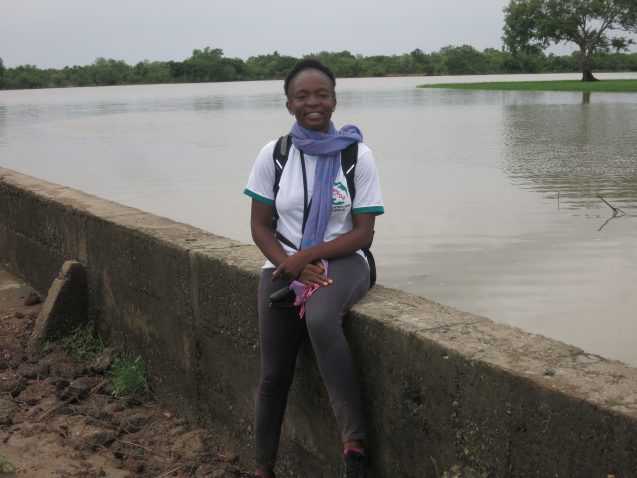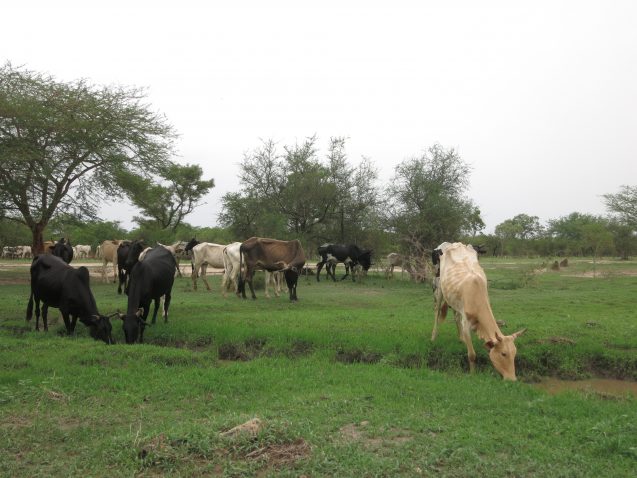Lisa Ilboudo Nébié: Studying Food Security, Environmental Changes and Migration in West Africa
This excerpt is from a Q&A that was originally published on the State of the Planet blog as part of a short series highlighting some of the Earth Institute’s women scientists as part of the International Day of Women and Girls in Science on February 11. Read more about the day and their related blog posts here.

As a human ecologist, Elisabeth Ilboudo Nébié looks at the impact of the environment on people. Also, how people are adapting to environmental change.
After graduating with a master’s in international development and social change, Ilboudo Nébié observed that one of the reasons why development projects have failed in the past was because they didn’t take the time to work closely with local communities. “I want to be the type of development practitioner who can work with local communities and that’s why the major I chose during my Ph.D. was anthropology,” said Ilboudo Nébié.

While working with her advisor, who focused on rural communities’ perceptions of climate change and the impact of climate change on their livelihoods, she decided to further delve into the interaction between the environment and communities.
After completing her Ph.D., Ilboudo Nébié won a competitive Earth Institute post-doctoral fellowship to study food security trends, environmental changes, the drivers of human migration, and climate services for pastoral communities in West Africa. She recently completed this research at Columbia University’s International Research Institute for Climate and Society (IRI), and now works at the International Development Research Centre in Canada.
In a conversation with State of the Planet, she spoke about her observations in the field as a human ecologist.
Can you tell us about your research on the relationship between the re-greening of the West African Sahel (a semi-arid region that extends from Senegal to Sudan) and food security trends?
The Sahel region of West Africa used to be considered a desertification hotspot. But in the last decades, studies have shown that the area has been re-greening. We are delving into what is the impact of this visible re-greening on food security and it is a long-term project. But for the past two years, we looked at climate shocks and their impact on food security.
We wanted to do this research work in Burkina Faso (a landlocked country in West Africa that has endured recurring droughts) but due to security reasons caused by political unrest in the country, we focused most of our research work in Senegal. We are trying to find out how climate shocks impact food security in the country, and also to identify households that are more or less food secure. I conducted this first study with my mentor, Alessandra Giannini, a climate scientist at IRI, in collaboration with Diaba Ba, the head of Vulnerability Analysis Mapping Unit in the country office of the World Food Programme in Senegal.

What were some of the findings from your research work in the last two years that surprised you the most?
The southern part of Senegal is more humid but it’s also the least food secure area in the country. This was surprising for me because you would normally expect a humid region to receive good rainfall and satisfactory agricultural production. But that’s not what we saw in Senegal. One of the plausible explanations for this is the ongoing Casamance conflict between the government of Senegal and natives of this region, who are ethnically and religiously distinct from the rest of the country and are pressing for their independence. Another possible explanation is poor access to southern areas in terms of transportation. South Senegal is far away from urban centers. The Casamance region of southern Senegal is actually separated from the rest of the country by the Gambia, which makes reaching Dakar, where the economy is concentrated, complicated.
What could be some of the reasons why the Sahel region has been experiencing re-greening?
At a small-scale level, farmers in the Sahel have taken up initiatives to grow more trees and there have been other local water and soil conservation initiatives as well. This pattern of re-greening is very patchy. It is only since the last 30 years when rainfall has started improving in this region of Africa. But when you look at annual rainfall from one year to another one, it varies. We plan on going to areas that have witnessed some re-greening to learn more about these local water and soil conservation initiatives, and also visit other areas that are still arid, to gain a better understanding of the ground realities. When I was still in my Ph.D. program and conducted fieldwork in a community in Burkina Faso where locals were involved in initiatives for the conservation of water and soil, the locals claimed that famines, as they experienced them in the past, cannot happen anymore because of their increasing access to early warning systems and adaptation strategies. So definitely there is a relationship between using these adaptation techniques and also having better agricultural productivity.
This is an excerpt from a longer piece from the State of the Planet blog. Read the rest here.

You must be logged in to post a comment.